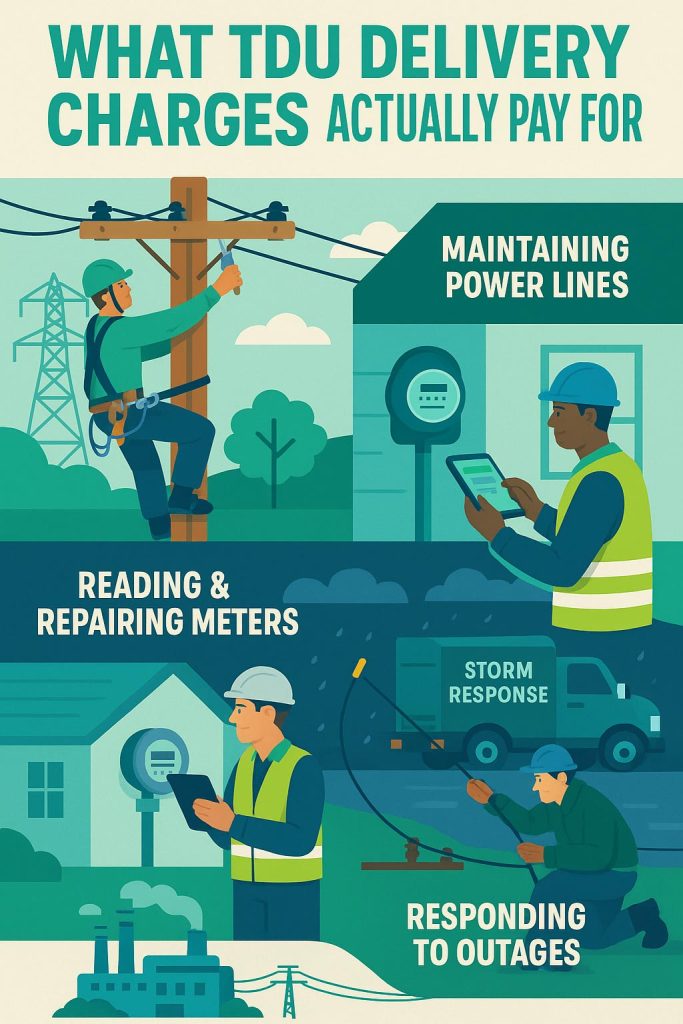Key Takeaways
- TDU Delivery Charges cover the cost of delivering electricity to your home, including maintenance, meter reading, and storm repairs, regardless of which electricity provider you choose.
- These charges are set by the state and are the same for everyone in your service area, so you can’t shop around for a cheaper TDU.
- The charges are split into a fixed monthly fee and a usage-based fee, meaning the more electricity you use, the higher your delivery charge.
- You can’t lower the fixed part, but you can reduce your delivery costs overall by using less electricity, through smart thermostats, better insulation, and energy-efficient habits.
If you’ve looked at your electric bill and noticed a mysterious line item called a “TDU Delivery Charge”, you’re not alone, and you’re definitely not the first to wonder what the heck is this and why am I paying for it?
What Is a TDU Delivery Charge?

TDU stands for Transmission and Distribution Utility. These are the companies that own and maintain the power lines, poles, transformers, and meters that deliver electricity to your home, regardless of which retail electric provider (REP) you buy your electricity from.
The TDU Delivery Charge is the fee you pay to your local utility for the physical delivery of electricity. Think of it like a delivery fee for getting electricity from the power plant to your porch light. It includes the cost of:
- Maintaining poles, wires, and meters
- Repairing outages and downed lines
- Reading your meter and reporting usage
- Ensuring electricity reliably reaches your home
Even if you switch electricity providers, your TDU remains the same and so does this charge.
How Are TDU Delivery Charges Calculated?
TDU charges are regulated by the Public Utility Commission (PUC) and are the same for everyone in a given service area, regardless of your provider or plan.
These charges usually come in two parts:
- Fixed Monthly Fee: A flat charge you pay each month (e.g., $4–$10 depending on your area)
- Usage-Based Charge: A per-kilowatt-hour (kWh) fee based on how much electricity you use
Here’s a simplified example (charges vary by region and are updated periodically):
| Component | Example Rate |
|---|---|
| Fixed Monthly Fee | $5.50 |
| Per kWh Usage Fee | $0.045 per kWh |
| Your Monthly Usage | 1,000 kWh |
| Total Delivery Charge | $5.50 + (1,000 × $0.045) = $50.50 |
So in this case, your delivery charges would be $50.50, just for the cost of getting power to your home.
Why Are These Charges Separate From My Energy Rate?
In Texas’ deregulated electricity market, the electricity you use and the wires that bring it to you are handled by two different entities:
- Retail Electric Provider (REP): Sells you electricity and sets your energy rate.
- TDU: Delivers the electricity and maintains the infrastructure.
This separation gives you the power to shop for the best electricity plan while still relying on the same utility for reliable delivery and service.
So even if you switch from TXU to Gexa or Reliant, for example, your poles and wires are still managed by the same TDU, such as CenterPoint, Oncor, TNMP, AEP North, or AEP Central, depending on where you live.
Can I Lower My TDU Delivery Charges?
Unfortunately, you can’t shop around for a cheaper TDU, your local utility is assigned based on where you live. And since TDU charges are regulated by the state, there’s no negotiating them.
BUT, you can reduce your delivery charges indirectly by using less electricity, because part of the charge is based on your usage.
Here are some helpful tips:
- Lower your energy usage: The less kWh you use, the lower your usage-based delivery fees.
- Use a smart thermostat: Helps reduce energy waste, especially during peak times.
- Upgrade to LED lighting: They use less energy and last longer.
- Run large appliances at night: When demand is lower (and sometimes cheaper).
- Improve insulation & sealing: Keep your home cooler in summer and warmer in winter without overworking your AC or heater.
These energy-saving habits won’t eliminate your fixed monthly charge, but they will reduce the usage-based part, and that can add up over time.
Who Are the TDUs in Texas?
There are five main TDUs in Texas, each serving different regions:
| TDU | Area Covered |
|---|---|
| Oncor | Dallas/Fort Worth, much of North TX |
| CenterPoint | Houston and surrounding areas |
| AEP Central | Corpus Christi, Rio Grande Valley |
| AEP North | Abilene, San Angelo, and more |
| TNMP | Parts of West, Central, and Gulf Coast TX |
To find out which TDU serves your address, you can usually check your electricity bill or ask your provider.
Other Helpful Things to Know
- TDU charges appear on all plans, whether you’re on a fixed-rate, variable-rate, or prepaid plan. They’re passed through without markup.
- They’re updated twice a year, usually around March and September.
- If your power goes out, you should call your TDU, not your electricity provider, they’re the ones who fix the lines.
- Many TDUs offer energy efficiency programs or rebates for things like smart thermostats, attic insulation, or A/C tune-ups.
While TDU Delivery Charges might feel like an annoying mystery fee, they actually play a crucial role in keeping your lights on and your electricity flowing safely and reliably. Think of them as the price for a well-maintained, responsive, and dependable energy delivery system.
Even though you can’t shop around for a better TDU, staying mindful of your energy use can help you lower this part of your bill over time, and every little bit helps.
FAQs About TDU Delivery Charges
Why am I being charged for TDU Delivery if I have a retail electric provider (REP)?
Do TDU Delivery Charges change?
Why did my TDU Delivery Charges increase?
– Infrastructure upgrades.
– Storm recovery costs.
– Regulatory adjustments.
Where can I see my TDU Delivery Charges on my bill?
Are TDU Delivery Charges taxed?
Can I avoid paying TDU Delivery Charges?
About the Author
David has been an integral part of some of the biggest utility sites on the internet, including InMyArea.com, HighSpeedInternet.com, BroadbandNow.com, and U.S. News. He brings over 15 years of experience writing about, compiling and analyzing utility data.
